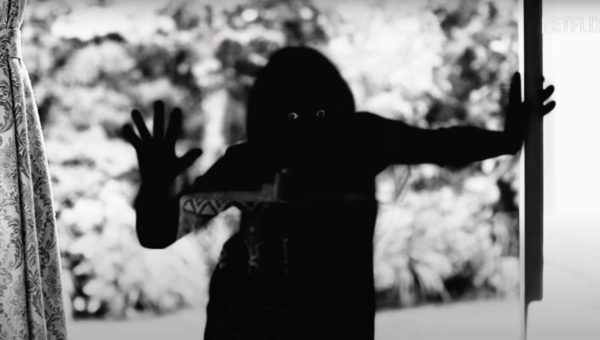
Netflix’s prequel series JU-ON: Origins offers a fresh perspective of the traditional and long-running Japanese horror series that doesn’t require much knowledge of the extensive franchise.
Spoilers ahead for episodes 4-6…
This review covers the last three episodes of the season. Our mostly spoiler-free review of the front half is posted over at Gayly Dreadful.
Please be mindful that the new series includes a myriad of content warnings, including sexual assault and child murder.
JOE
I think I’ve started this piece a half dozen times in my head because I’m not exactly sure how to approach the latter half of this prequel series, Terry. When we wrote up our piece on the first part of the season, we were intrigued, mildly put off and, most of all, uncertain about what lay ahead.
The answer, apparently, is quite a bit more of the same! After the time jump in episode three, we speculated that the season might be grouped into pairs set in the same time period. This meant that every two episodes, the show would jump ahead to focus on new inhabitants of the cursed house, as well as check-in on any surviving characters.
It turns out that we were kinda correct, as the infidelity plotline that began in episode three carries over (in extremely graphic form) in episode four. We see put-upon Masaki initially poisoned by his pregnant wife, whom he kills before carving out the baby and burying it in the front yard of the murder house.
Then, in the final two episodes, which take place in 1995 and 1997, we see our remaining characters face their demons in various ways. Kiyomi Kawai (Ririka), the girl who was raped in episodes one and two, murders her ex-husband in cold blood, then returns to the cursed house where the ghosts of Yoshie Minakami (Nana Owada) and Mai Hyodo (Hitomi Hazuki) apologize and lead her away to…something (likely death, but this is unconfirmed).
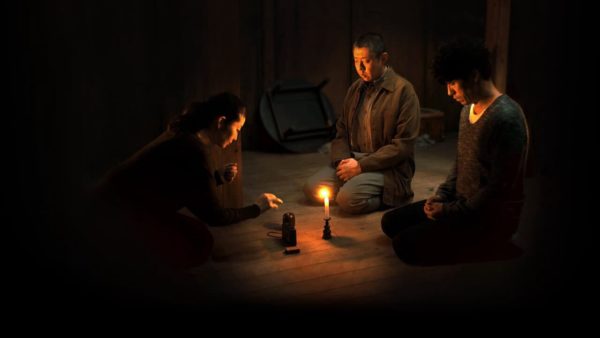
Meanwhile paranormal author Yasuo Odajima (Yoshiyoshi Arakawa) and actress Haruka Honjo (Yuina Kuroshima) eventually discover the house’s location. In an attempt to warn/protect the current occupants – gruff Yu (Atom Shukugawa) and his more pliable pregnant wife, Tomoko (Yura Anno) – the two JU-ON: Origins mainstays wind up performing a makeshift summoning spell with Haruka’s mother-in-law. Odajima also realizes that his whole family died because he grew up in the house, then both Haruka and her mother-in-law wind up dying and Yu (and Odajima’s father in black & white flashback) apparently…explode?
Terry, I’m unsure if this level of plot synopsis is required, if only because JU-ON: Origins turned out to be a disappointingly repetitious exploration of the same idea. Fans familiar with the property know that anyone who sets foot in the cursed house are doomed to die, which is exactly what happens here (often to women and children). Seeing a new slate of victims turn up every few episodes, with very little character development, and none of the franchise’s signature time-jumps, meant that this was basically an exercise in watching unknown people get brutally murdered.
There was an opportunity to explore some new avenues, particularly in Odajima’s story as an orphan who survived the tragedy of the house by effectively writing its biography, but JU-ON: Origins never digs deeper than that. More disappointing is how poorly Haruka and Kiyomi are treated by the narrative: Kiyomi’s fate is uncertain (she isn’t really mentioned again and her body is never discovered) and Haruka is killed in a last minute jump scare that portends a potential second season. It’s so bizarre that I literally DM’d you to ask if we were missing episodes because it doesn’t feel like the end of the season at all!
Terry, I’m curious about your feelings now that we’ve seen how everything does – or doesn’t – come together. Were you, like me, on board until the final episode? Were you hoping for more of an arc for Haruka, Odajima, Kiyomi and even Odajmi’s assistant, Ariyasu (Kana Kurashina)? Is there anything significant about the news stories of murders and terrible events that play on TVs throughout the series? And, most importantly, is there something more to the origin of the curse, involving a pregnant woman who murders her threatening husband and then somehow winds up dead herself, that I missed? ‘Cause I didn’t understand why or how it differs from any of the other murders.
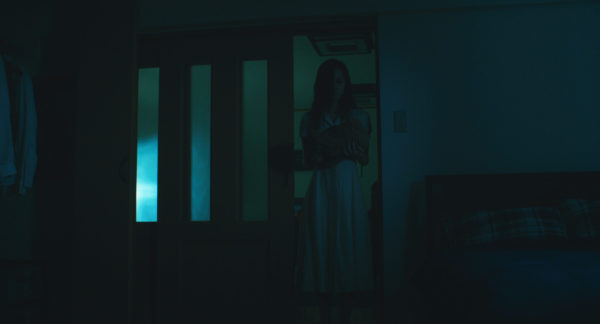
TERRY
Boy, this is a tricky one, Joe. Like you, I’ve looked at this blank page trying to figure out exactly what to say. I didn’t dislike this prequel series. In fact, as a mood piece, I found it haunting and disturbing. And if this were an hour and a half movie that I could just soak in, I probably would have left the theatre with a knot in my stomach. It’s more about setting a mood than telling a story or featuring rich characters.
This is the difference between film and television. With film, you need to establish everything very quickly so you can move along with the plot while the lengthier runtime of television allows writers the ability to dig deep with the characterizations. Right or wrong, that seems to be the general expectations of the medium.
So when something like JU-ON: Origins comes around and gives us little to nothing in the way of character development and eschews what people have come to expect in the New Golden Age of TV in order to focus on being a creepy experiment in mood…well, it’s kind of disappointing.
But from that experiment, I did find some things to love. For one, I didn’t realize until I had finished the show that the makeup and modelling effects were by Screaming Mad George (Society, A Nightmare on Elm Street 4: The Dream Master) and he continues to give us some goopy, gory and quite frankly surreal moments. From the shot of the phone in Chie’s stomach to the fetus attack, I found myself with a, to quote you, “Grudge-Face,” frozen in a mix of horror, shock and bemusement.
The shot of the fetus eating Keiichi’s food before turning to him with unseeing eyes and then crawling on him and then inside his fucking mouth…I mean, it’d be so hilarious if it weren’t so surreal and absurdly horrifying.
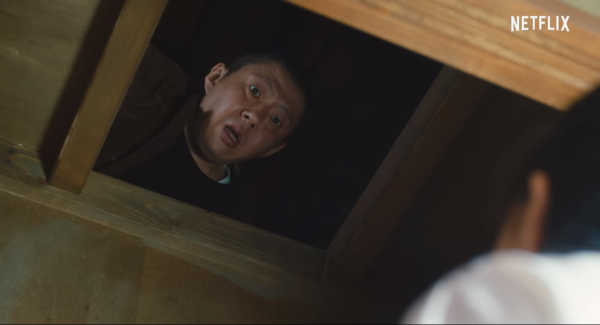
I also really enjoyed the moments when Odajima and the house felt out of time. The mix of black and white flashbacks and scenes of the past repeating in the present really worked for me. I just wish it had tied everything together a bit more. From my experience with J-Horror, I know there’s a lot more ambiguity than North American cinema traditionally focuses on and I typically thrive on that ambiguity. But this felt impossibly inscrutable on first viewing. I do feel like you and I both missed something and I’m wondering if it has something to do with the time-traveling aspect of the house.
One thing that the back half stressed was the way in which time is immaterial in the house and we saw people from the past interact with people in the present. I bring this up because there’s the one throwaway line from Kiyomi tells her ex-husband that their son Toshiko isn’t his and that she was given him. I’m wondering if he, to address your question, is the baby from the original curse and since he’s now in a coma, the curse will continue. This is a wild guess because, honestly, JU-ON: Origins doesn’t give us much to go on.
I’m also curious about the news reports, Joe. But I have no clue outside of the subtle suggestion that there’s a sickness inside Japan that the house is a metaphor for? Even without the horrors of the house, the events happening in the country seemed pretty messed up, from beheadings to sarin gas attacks and more…do you have any thoughts on this?
I also have to ask, Joe, since this (presumably) first season didn’t do much character development, were you as gagged as I was with the horror sequences? Would this exercise in mood have worked better as a more-focused movie, rather than a three hour series? And were you disappointed that the mysterious serial-murderer M (Tokio Emoto) was introduced only to be used in like two scenes? What was up with his story?

JOE
I’ll confess that when I posed the question about the news stories, I basically had the same interpretation as you, but I wasn’t sure if perhaps I was just missing something that would crack it wide open. Ultimately I think it’s just to confirm that there’s something malicious afoot in Japan (though is the house a reflection of current events or are current events tied to the house’s continued existence?)
Oh yeah, the gore is definitely the reason to tune into this. If dread and/or gore is your thing, JU-ON: Origins is a good fit for you. Story-wise, I definitely wanted more, but I can’t complain about those delicious, icky practical effects or the mean streak that runs through these six episodes.
I will definitely admit that I was uncertain why M was introduced. When he appeared waaaay back in episode one, it’s a shocking and abrupt moment of child violence. When he returns in the fourth episode, it seemed like he was going to be a more significant player, but nope! He just cues the investigator to scour the obituaries for recurring appearances of a certain house (at which time Odajima and Ariyasu almost immediately stumble upon it). Sure, I guess…

The truth is that those early episodes didn’t offer us by way of character development, so it was probably misguided of us to expect something more in the back half. I do think that Odajima’s storyline comes together best; he gets something approaching an arc, what with his back story and the visually interesting, but mildly confusing flashbacks.
Overall, this works decently well for me. The shorter episode length and six episodes ensured that I was never bored and I think that as long as audiences know to put on their J-Horror hats and focus more on the atmosphere than characters, they’ll enjoy the ride. It’s somewhere between a 3 and a 3.5/5 for me.
Terry, do you think you need to be a fan of the franchise or, more broadly speaking, a fan of J-Horror to truly appreciate JU-ON: Origins? We posted content warnings over both of our reviews, but do you think jaded horror fans will think we’re overreacting? And, finally, what’s your score for season one?
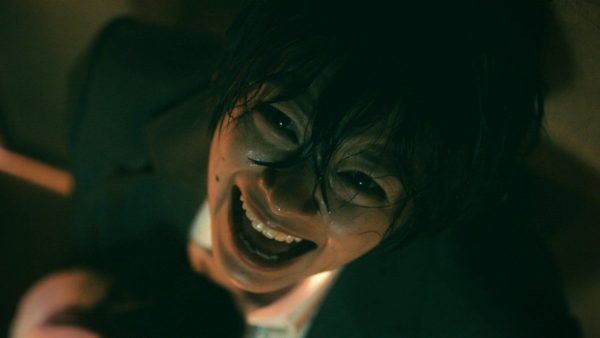
TERRY
I did wonder if people would think we’re overreacting with the content warnings, but while Ju-On and its American remake are dark, I don’t remember them reaching quite the same level of explicit darkness that JU-ON: Origins reaches, so I think it’s warranted. Those coming to this show expecting a spooky woman with hair covering her face, dragging herself down a staircase with a gurgling croak will probably be as surprised at the content as we were. I feel that I’m pretty jaded as a horror fan and desensitized (for reference, The Last Of Us Part II did not affect me the way it has a lot of people in its depictions of violence), but I also wasn’t expecting the tone and the explicit nature of this show. So it only feels fair.
Someone asked me on Twitter whether they needed to have seen earlier Ju-On/The Grudge films and I honestly don’t think so. While there’s a few little homages like the mewing and the croaking, this felt pretty divorced from the franchise’s complicated narrative and stands on its own. That said, if you aren’t a fan of J-Horror and its ambiguities, you might find yourself annoyed that the story is pretty inscrutable.
All this to say that I did enjoy JU-ON: Origins and I’m curious where the story will take us, if it gets renewed. But I wasn’t as in love with it as I thought I’d be. I thought episode 4 was an almost impeccable standout and that episode would be 4.5/5 for me, but as a whole I think I’m hovering around a 3/5, as well.